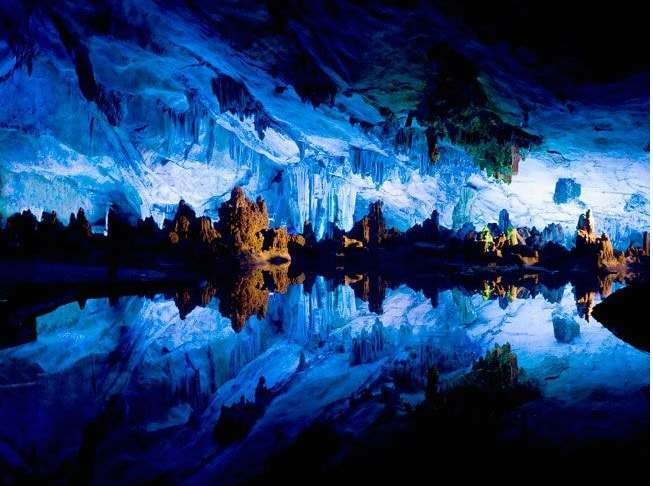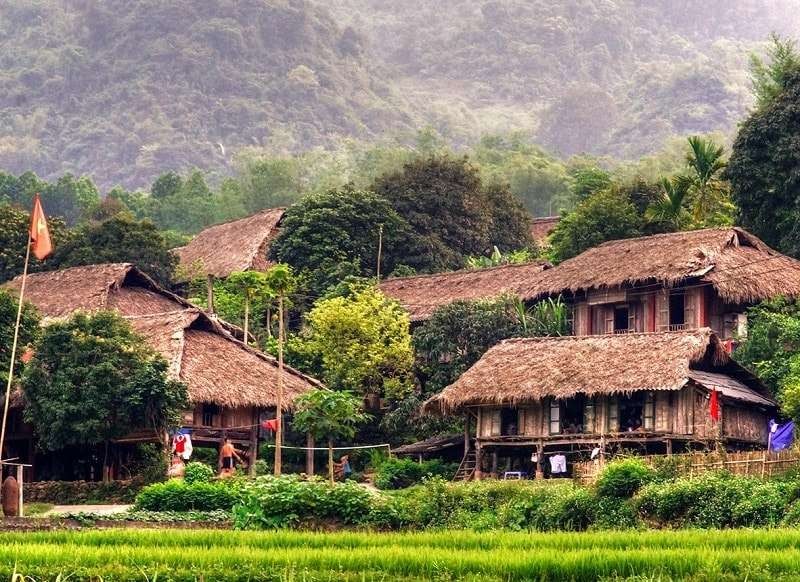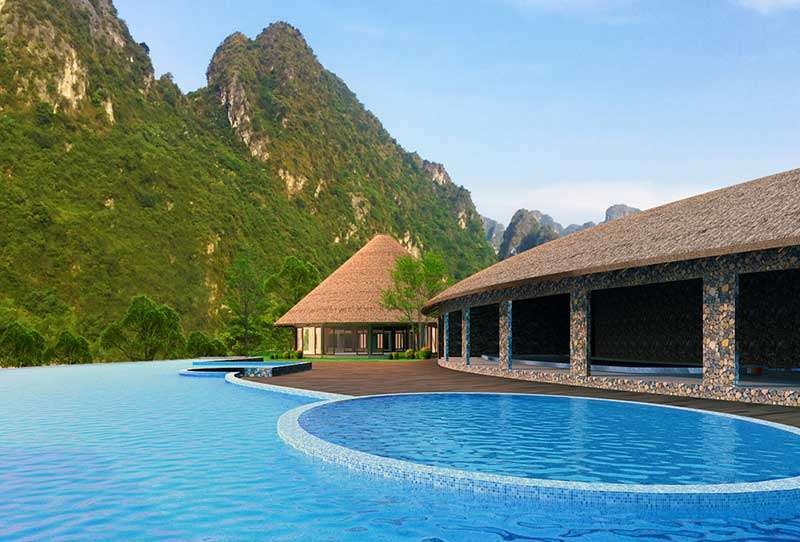Are you dreaming of an adventurous exploration of Vietnam’s captivating caves? Discover the challenges and rewards of venturing into caves like Da Bac or Tien Phi with SIXT.VN. We will help you assess the difficulty level and prepare for an unforgettable caving experience.
Exploring caves such as Da Bac or Tien Phi in Vietnam presents a moderate level of difficulty, demanding a basic level of fitness and a spirit for adventure, but SIXT.VN will guide you through every step of the way to make it an exciting and safe experience. This guide dives deep into what you can expect, how to prepare, and why these natural wonders are absolutely worth the effort. With insights into the caves’ unique features and tips for a smooth journey, you will be well-equipped to embark on your caving adventure, and SIXT.VN ensures you’re well-prepared to uncover the hidden gems of Vietnam.
1. Understanding the Allure of Da Bac and Tien Phi Caves
1.1. A Glimpse into Da Bac Cave
Da Bac Cave, often called “Fairy Cave,” is a mesmerizing destination approximately 50 km from Hoa Binh city. The cave stretches over 70 meters in length with a height of 2 meters, making it easily accessible for most visitors. Inside, the beauty of the rocks and stalactites is enhanced by strategic lighting, creating a magical environment.
 The enchanting beauty inside Da Bac Cave, illuminated to highlight its unique rock formations and stalactites
The enchanting beauty inside Da Bac Cave, illuminated to highlight its unique rock formations and stalactites
1.2. Discovering Tien Phi Cave
Located on Thung Phi Hill in Hoa Binh City, Tien Phi Cave enchants visitors with its stalactites that resemble a fairy in a graceful flying posture. The journey to the cave involves traversing foliage of royal poinciana, eucalyptus, and green bamboo. Upon entering, you’ll be greeted by the dark yellow ground and towering stone arches adorned with numerous stalactites.
 The magical interior of Tien Phi Cave, showcasing its natural formations and serene atmosphere
The magical interior of Tien Phi Cave, showcasing its natural formations and serene atmosphere
1.3. What Makes These Caves Special?
Both Da Bac and Tien Phi caves offer unique geological formations, cultural significance, and natural beauty. They represent a blend of adventure and serene exploration, attracting tourists seeking to connect with nature and discover hidden gems.
2. Assessing the Difficulty Level: Factors to Consider
2.1. Physical Fitness Requirements
Exploring caves requires a moderate level of physical fitness. Expect to do some walking, climbing, and possibly crawling, depending on the specific cave and the routes you choose to explore.
2.2. Terrain Conditions
The terrain inside caves can be uneven, slippery, and sometimes narrow. Be prepared for varied conditions, including wet surfaces and rocky paths. Wearing appropriate footwear is essential for navigating these environments safely.
2.3. Accessibility
The accessibility of the caves varies. Some caves have well-maintained paths and lighting, while others may require more adventurous trekking to reach the entrance and explore the interior.
2.4. Guided vs. Independent Exploration
Deciding whether to explore with a guide or independently can significantly impact the difficulty level. Guided tours often provide valuable insights, safety measures, and equipment, making the experience more manageable, especially for beginners.
2.5. Environmental Factors
Consider the environmental conditions inside the caves, such as humidity, temperature, and air quality. Caves can be damp and cooler than the outside environment, so dressing appropriately is important.
3. Detailed Breakdown of Potential Challenges
3.1. Navigation and Orientation
3.1.1. Getting Lost
One of the primary concerns when exploring caves is the risk of getting lost. Caves can be complex labyrinths, and without proper guidance or navigational skills, it’s easy to lose your way.
3.1.2. Lack of Natural Light
Caves are dark environments, and relying solely on natural light is not an option. Artificial lighting is essential, but it can also distort perception and make navigation challenging.
3.1.3. Complex Cave Systems
Many caves have intricate systems of tunnels and chambers. Without a map or guide, it’s difficult to keep track of your location and the direction you’re heading.
3.2. Physical Exertion
3.2.1. Climbing and Crawling
Navigating through caves often involves climbing over rocks and crawling through narrow passages. This can be physically demanding, especially for those with limited mobility or fitness.
3.2.2. Stamina
Cave exploration can last for several hours, requiring a good level of stamina. Fatigue can set in quickly, making it harder to navigate and increasing the risk of accidents.
3.2.3. Uneven Terrain
The uneven terrain inside caves can be hard on your feet and ankles. Constant adjustments to maintain balance can lead to muscle strain and fatigue.
3.3. Safety Hazards
3.3.1. Slippery Surfaces
Water and moisture inside caves can create slippery surfaces, increasing the risk of falls and injuries.
3.3.2. Falling Rocks
Loose rocks and debris can fall from the ceiling or walls of the cave, posing a threat to those below.
3.3.3. Wildlife
Caves are home to various forms of wildlife, including bats, insects, and spiders. While most are harmless, some may pose a risk of bites or stings.
3.4. Psychological Challenges
3.4.1. Claustrophobia
The confined spaces inside caves can trigger claustrophobia in some individuals, leading to anxiety and panic.
3.4.2. Fear of the Unknown
The darkness and mystery of caves can create a sense of unease and fear, especially for those who are not used to exploring such environments.
3.4.3. Isolation
Being deep inside a cave can create a sense of isolation, which can be unsettling for some people.
4. Essential Gear and Preparation
4.1. Appropriate Clothing
Wear comfortable, durable clothing that you don’t mind getting dirty. Long sleeves and pants are recommended to protect against scratches and insect bites.
4.2. Sturdy Footwear
Choose sturdy hiking boots or shoes with good traction to navigate slippery and uneven surfaces.
4.3. Lighting
A reliable headlamp is essential for hands-free navigation. Bring extra batteries in case your light runs out.
4.4. Safety Gear
Depending on the complexity of the cave, you may need a helmet, gloves, and knee pads for added protection.
4.5. Navigation Tools
A map, compass, or GPS device can be helpful for navigating complex cave systems. However, remember that GPS signals may not work inside caves.
4.6. First Aid Kit
Carry a basic first aid kit with essentials like bandages, antiseptic wipes, pain relievers, and any personal medications you may need.
4.7. Food and Water
Bring enough water and snacks to keep you hydrated and energized during your exploration.
4.8. Communication Devices
A whistle can be used to signal for help in case of an emergency. A fully charged cell phone or satellite phone can be useful for communication, but remember that cell service may be limited inside caves.
4.9. Backpack
A comfortable backpack is essential for carrying all your gear. Make sure it fits well and doesn’t restrict your movement.
4.10. Personal Items
Bring sunscreen, insect repellent, and any other personal items you may need.
5. Maximizing Safety and Enjoyment
5.1. Pre-Trip Planning
5.1.1. Research
Research the cave you plan to explore. Understand its layout, potential hazards, and any specific gear requirements.
5.1.2. Check Weather Conditions
Check the weather forecast before your trip. Avoid exploring caves during heavy rain or storms, as this can increase the risk of flooding and landslides.
5.1.3. Inform Someone of Your Plans
Tell a friend or family member about your plans, including your route, expected return time, and contact information.
5.2. During the Exploration
5.2.1. Stay on Marked Trails
If the cave has marked trails, stick to them. Venturing off the trail can increase the risk of getting lost or injured.
5.2.2. Watch Your Step
Pay attention to where you’re walking and avoid stepping on loose rocks or unstable surfaces.
5.2.3. Be Aware of Your Surroundings
Keep an eye out for potential hazards, such as falling rocks, slippery surfaces, and wildlife.
5.2.4. Conserve Your Energy
Pace yourself and take breaks as needed to avoid fatigue.
5.2.5. Stay Hydrated and Nourished
Drink water and eat snacks regularly to maintain your energy levels.
5.2.6. Monitor Your Group
If you’re exploring with a group, keep an eye on each other and make sure everyone is doing okay.
5.2.7. Turn Back If Necessary
If you encounter any difficulties or feel uncomfortable, don’t hesitate to turn back. It’s better to be safe than sorry.
5.3. Post-Trip
5.3.1. Debrief
After your trip, take some time to debrief. Discuss what went well, what could have been better, and any lessons learned.
5.3.2. Clean and Inspect Gear
Clean and inspect your gear to make sure it’s in good condition for your next adventure.
5.3.3. Share Your Experience
Share your experience with others. This can help them prepare for their own caving adventures and promote responsible cave exploration.
6. Why Choose SIXT.VN for Your Caving Adventure?
6.1. Expert Guidance
SIXT.VN provides expert guidance and support to ensure a safe and enjoyable caving experience. Our experienced guides are knowledgeable about the caves and can provide valuable insights and safety tips.
6.2. Tailored Experiences
We offer tailored experiences to suit your interests and fitness level. Whether you’re a beginner or an experienced caver, we can create a customized itinerary that meets your needs.
6.3. Safety First
Safety is our top priority. We provide all necessary safety gear and ensure that our guides are trained in first aid and emergency response.
6.4. Convenience
SIXT.VN takes care of all the logistics, from transportation to accommodation, so you can focus on enjoying your adventure.
6.5. Local Knowledge
Our local knowledge and connections allow us to provide unique and authentic experiences that you won’t find anywhere else.
6.6. Comprehensive Services
6.6.1. Tour Packages
SIXT.VN offers comprehensive tour packages that include transportation, accommodation, meals, and guided cave explorations. These packages are designed to provide a hassle-free and immersive experience.
6.6.2. Airport Transfers
We provide reliable and comfortable airport transfer services to ensure a smooth arrival and departure. Our drivers are experienced and knowledgeable about the area, so you can relax and enjoy the ride.
6.6.3. Hotel Booking
SIXT.VN can help you find the perfect accommodation for your caving adventure. We offer a wide range of options, from budget-friendly guesthouses to luxury hotels.
6.6.4. Ticket Booking
We can assist you with booking tickets for cave entrances, tours, and other attractions. This can save you time and ensure that you don’t miss out on any must-see experiences.
6.6.5. Flight Booking
SIXT.VN can help you find the best flights to Vietnam. We work with a network of airlines to offer competitive prices and convenient flight schedules.
6.7. Customer Support
Our customer support team is available 24/7 to answer your questions and provide assistance. We’re committed to ensuring that your caving adventure is a success.
7. Preparing for Your Trip with SIXT.VN
7.1. Booking Your Adventure
7.1.1. Online Booking
Visit our website, SIXT.VN, to browse our tour packages and book your caving adventure online.
7.1.2. Contact Us
Contact our customer support team via phone or email to discuss your specific needs and preferences. We’re happy to help you create a customized itinerary.
7.2. Pre-Departure Checklist
7.2.1. Confirm Bookings
Confirm all your bookings, including flights, accommodation, tours, and transfers.
7.2.2. Pack Appropriately
Pack all the necessary gear and clothing for your caving adventure.
7.2.3. Obtain Travel Insurance
Purchase travel insurance to protect yourself against unexpected events, such as medical emergencies, trip cancellations, and lost luggage.
7.2.4. Notify Your Bank
Notify your bank of your travel plans to avoid any issues with your credit or debit cards.
7.3. Arrival in Vietnam
7.3.1. Airport Pickup
Our driver will be waiting for you at the airport to take you to your accommodation.
7.3.2. Check-In
Check in to your accommodation and take some time to relax and adjust to the new environment.
7.3.3. Orientation
Attend an orientation meeting with your SIXT.VN guide to discuss the itinerary, safety procedures, and any other important information.
8. Enhancing Your Exploration: Tips and Tricks
8.1. Mastering Cave Photography
8.1.1. Lighting Techniques
Learn how to use artificial lighting to capture stunning photos inside caves. Experiment with different angles and intensities to highlight the unique features of the cave.
8.1.2. Composition
Pay attention to composition to create visually appealing photos. Use leading lines, symmetry, and the rule of thirds to guide the viewer’s eye.
8.1.3. Equipment
Invest in a good camera and tripod for taking high-quality photos in low-light conditions.
8.2. Identifying Geological Formations
8.2.1. Stalactites and Stalagmites
Learn how to identify stalactites (hanging from the ceiling) and stalagmites (rising from the ground). These formations are created by the slow dripping of mineral-rich water over thousands of years.
8.2.2. Flowstones
Flowstones are sheet-like deposits of calcium carbonate that form on the walls and floors of caves. They can create beautiful and intricate patterns.
8.2.3. Columns
Columns are formed when a stalactite and stalagmite meet, creating a solid pillar from the ceiling to the ground.
8.3. Understanding Cave Ecology
8.3.1. Cave-Dwelling Animals
Learn about the various animals that live in caves, such as bats, insects, and spiders. Understand their adaptations to the cave environment and their role in the ecosystem.
8.3.2. Cave Plants
Some caves are home to unique plant species that have adapted to the low-light conditions. Learn how to identify these plants and understand their importance to the cave ecosystem.
8.3.3. Conservation
Understand the importance of cave conservation and how to minimize your impact on the cave environment. Avoid touching or damaging formations, and pack out all your trash.
9. Alternative Activities in Hoa Binh
9.1. Exploring Thung Khe Pass
Thung Khe Pass offers stunning views of Mai Chau valley. It’s a great spot for photography and enjoying the natural beauty of the region.
 Thung Khe Pass, offering breathtaking views of the surrounding landscapes
Thung Khe Pass, offering breathtaking views of the surrounding landscapes
9.2. Visiting Ban Lac Village
Ban Lac Village is a traditional Thai village where you can experience the local culture and enjoy the peaceful atmosphere.
 Ban Lac Village, showcasing the traditional stilt houses and cultural richness of the Thai ethnic people
Ban Lac Village, showcasing the traditional stilt houses and cultural richness of the Thai ethnic people
9.3. Relaxing at Kim Boi Mineral Spring
Kim Boi Mineral Spring is known for its therapeutic waters. It’s a great place to relax and rejuvenate after a day of caving.
 Kim Boi Mineral Spring, where visitors can relax and enjoy the therapeutic benefits of the natural mineral water
Kim Boi Mineral Spring, where visitors can relax and enjoy the therapeutic benefits of the natural mineral water
9.4. Discovering Mai Chau Valley
Mai Chau Valley is a picturesque region with rice paddies and traditional villages. It’s a great place for hiking, cycling, and experiencing rural Vietnamese life.
 The scenic beauty of Mai Chau in the rice harvest season
The scenic beauty of Mai Chau in the rice harvest season
10. Frequently Asked Questions (FAQs)
10.1. What is the best time of year to explore caves in Vietnam?
The best time to explore caves in Vietnam is during the dry season, which typically runs from November to April. The weather is cooler and drier, making it more comfortable to explore the caves.
10.2. Do I need a permit to explore Da Bac and Tien Phi caves?
It depends on the specific cave and the local regulations. It’s best to check with SIXT.VN or the local tourism office to determine if a permit is required.
10.3. Are there any age restrictions for cave exploration?
Age restrictions may vary depending on the specific cave and the tour operator. Generally, children should be accompanied by an adult, and there may be a minimum age requirement for certain activities.
10.4. Can I explore the caves on my own, or do I need a guide?
While it’s possible to explore some caves on your own, it’s generally recommended to go with a guide, especially if you’re not experienced in caving. A guide can provide valuable insights, safety tips, and ensure that you don’t get lost.
10.5. What should I do if I encounter wildlife inside the caves?
If you encounter wildlife inside the caves, it’s important to remain calm and avoid disturbing the animals. Keep a safe distance and do not attempt to touch or feed them.
10.6. Are there any restrictions on photography inside the caves?
Some caves may have restrictions on photography, such as the use of flash photography. Check with your guide or the local tourism office to determine if there are any restrictions.
10.7. What should I do in case of an emergency inside the cave?
In case of an emergency inside the cave, stay calm and assess the situation. If possible, contact your guide or call for help using a cell phone or satellite phone. If you’re injured, administer first aid and wait for assistance.
10.8. How can I minimize my impact on the cave environment?
To minimize your impact on the cave environment, avoid touching or damaging formations, pack out all your trash, and stay on marked trails. Follow the principles of Leave No Trace.
10.9. What are the risks of flash floods in the caves, and how can I mitigate them?
Flash floods can occur in caves during heavy rain or storms. To mitigate the risk, check the weather forecast before your trip and avoid exploring caves during inclement weather. Be aware of the signs of rising water levels and be prepared to evacuate if necessary.
10.10. How do I book a tour with SIXT.VN?
You can book a tour with SIXT.VN by visiting our website, SIXT.VN, or contacting our customer support team via phone or email. We’re happy to help you plan your caving adventure and ensure that it’s a safe and memorable experience.
Exploring caves like Da Bac or Tien Phi in Vietnam offers a thrilling and rewarding experience. While there are challenges to consider, with proper preparation and guidance from SIXT.VN, you can enjoy these natural wonders safely and comfortably. So, are you ready to embark on your caving adventure? SIXT.VN is here to guide you every step of the way.
Ready to explore the hidden gems of Vietnam? Contact SIXT.VN today for expert guidance, tailored experiences, and unforgettable adventures!
Address: 260 Cau Giay, Hanoi, Vietnam
Hotline/Whatsapp: +84 986 244 358
Website: SIXT.VN
Plan your trip with confidence and experience the beauty of Vietnam’s caves like never before. Book your adventure now and create memories that will last a lifetime.



